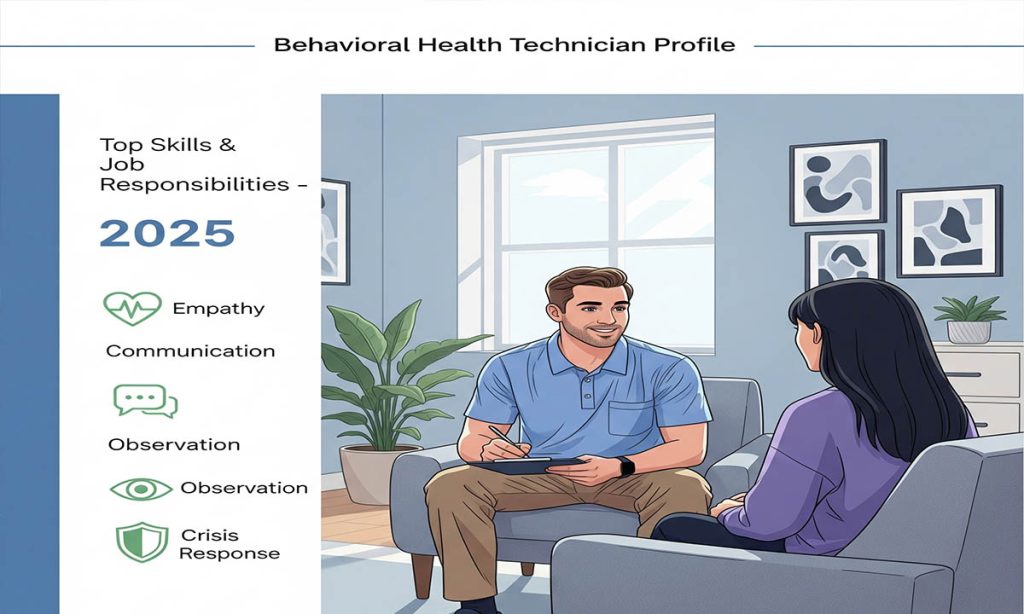Introduction: A Behavioral Health Technician (BHT) – also known as a mental health or psychiatric technician – provides front-line support to patients with mental health, substance use, or developmental challenges. These entry-level professionals work under licensed staff (nurses, therapists, counselors) to monitor patient progress, assist in daily care, and implement therapeutic activities. In this guide, we’ll cover the behavioral health tech salary, job description, required skills, training programs, and how to find positions near you (even “behavioral health tech jobs near me” searches). You’ll learn what it takes to enter this growing field, how to craft a strong resume, and the outlook for a career as a BHT.
Behavioral health tech roles are in demand: the U.S. Bureau of Labor Statistics projects 13% job growth (2023–33) for psychiatric and mental health technician roles – much faster than average. With the rising need for mental health services, BHTs can find many entry-level jobs in hospitals, clinics, rehab centers, and community agencies. This article explains the behavioral tech job description, essential skills and certifications (including “certified behavioral health tech” options), and salary expectations. Whether you’re exploring mental health technician jobs or aiming to advance in behavioral health, this guide has the expert insights, statistics, and tips you need for behavioral health technician.
A behavioral health technician provides comfort and support to a patient during treatment. This hands-on role requires empathy, observation skills, and the ability to work as part of a care team behavioral health technician.
What Is a Behavioral Health Technician?
A Behavioral Health Technician (often called a behavioral tech, mental health technician, or psychiatric aide) is a healthcare aide specializing in mental and emotional disorders. According to the BLS, psychiatric technicians “care for people who have mental or emotional conditions or developmental disabilities” – duties that are essentially identical for a behavioral health tech. In practice, a BHT’s core job description includes observing patient behavior, assisting with daily living activities, and helping implement treatment plans created by therapists or doctors.
Behavioral health techs may work in psychiatric hospitals, residential treatment facilities, outpatient clinics, group homes, or schools. They help clients manage behavioral problems, provide social support, and keep detailed records of progress. For example, a BHT might lead group activities, monitor a patient’s vital signs, provide medication (as directed by nurses), or restrain a patient who becomes violent. These tasks are outlined in the standard behavioral tech job description by the BLS: “Psychiatric technicians… typically monitor patients’ conditions and provide therapeutic care… including overseeing medications, leading recreational activities, and helping with daily living tasks” behavioral health technician.
Key aspects of the role include:
- Observation & Reporting: Watching for changes in mood or behavior and reporting them to the medical team.
- Patient Care: Assisting with eating, bathing, dressing, and other daily needs.
- Therapeutic Activities: Conducting group therapy, recreation, or skill-building sessions.
- Safety & Crisis Management: Restraining or calming patients during outbursts and ensuring a safe environment.
- Communication: Collaborating with doctors, nurses, therapists, and family members.
BHTs essentially bridge the gap between patients and professionals. They “listen to patients’ concerns, observe their behavior, and record their condition” daily. By building trust with clients, a BHT encourages positive habits and coping skills. Though the title “technician” suggests a technical role, much of the work is personal care and support in a therapeutic setting behavioral health technician.
Essential Skills & Responsibilities
Behavioral health technicians must blend technical skills with compassion. Employers look for candidates with strong communication, empathy, and problem-solving abilities. According to industry data, top skills for BHTs include mental health knowledge, behavior analysis, and patient care. In fact, resumes and job postings for BHT positions often emphasize: “mental health,” “behavior analysis,” “patient care,” “treatment planning,” “CPR,” and “communication skills”. These terms reflect the hands-on, clinical nature of the job behavioral health technician.
Core Technical Skills: In addition to soft skills, BHTs need some clinical abilities. Most job listings require basic CPR/First Aid certification, knowledge of taking vital signs (blood pressure, temperature, heart rate), and record-keeping. Familiarity with behavior monitoring and therapeutic interventions is key. For example, a strong resume would highlight experience with “behavior modification programs,” “patient documentation,” or “following treatment protocols.”
Interpersonal Skills: Equally important are communication and empathy. Behavioral health techs interact with patients who may be fearful, confused, or upset. The resume checklist from ZipRecruiter suggests emphasizing “Customer Service,” “Communication Skills,” and “Collaboration”. This means BHTs should show they can remain calm under pressure, work in a team, and establish rapport with diverse clients. Any experience working with children, seniors, or people with disabilities is relevant behavioral health technician.
Sample Responsibilities: The duties of a BHT include many tasks found in psychiatric technician roles:
- Monitoring & Documentation: Track patient vital signs and moods; record progress notes.
- Medication Assistance: Administer medications according to instructions (under supervision).
- Therapeutic Support: Lead or assist in group therapy, recreational activities, or behavioral programs.
- Daily Living Assistance: Help patients eat, dress, bathe, or attend appointments.
- Safety Procedures: Use de-escalation or physical restraint methods when patients pose a danger.
- Environmental Maintenance: Ensure the facility is clean and safe (e.g., changing linens, reporting hazards).
These responsibilities illustrate why behavioral tech job descriptions often list “observing behavior,” “restraint,” and “patient escort” as requirements. The role can be physically and emotionally demanding, but also highly rewarding for those who want to help others behavioral health technician.
Education, Training & Certification
Training Programs and Schools
Most behavioral health technician roles require at least a high school diploma or GED. Many employers prefer candidates with additional training or certification. You can obtain this through certificates or associate degree programs in behavioral or mental health. For example, many community colleges and vocational schools offer a Behavioral Health Technician certificate (often completed in 1 year). These programs cover psychology basics, crisis intervention, and hands-on practicum behavioral health technician.
Some key components of BHT training programs are:
- Behavioral Health Foundations: Courses in human growth, developmental disorders, and psychopathology.
- Clinical Skills: Training in CPR, first aid, and observing vital signs.
- Therapeutic Techniques: Learning behavior management, crisis de-escalation, and counseling basics.
- Ethics & Cultural Competence: Emphasis on patient rights, confidentiality, and working with diverse populations.
- Internship/Practicum: Clinical experience (e.g. 100+ hours) in hospitals or mental health agencies, supervised by professionals.
For instance, Marion Technical College’s BHT certificate “provides graduates the mental/behavioral health knowledge and skills… to implement essential care for individuals in a variety of mental health and developmental situations”. Students practice “behavior management, crisis and trauma intervention, and treatment planning”, ensuring they are job-ready. Community college programs often partner with local facilities to give hands-on experience behavioral health technician.
Schools & Programs: When searching for behavioral health tech schools or programs, look for accredited health or human services departments. Some keywords: “Behavioral Health Technician Certificate,” “Psychiatric Technician Program,” “Mental Health Technology”. For example, Reynolds Community College and Yavapai College (AZ) offer BHT training. Even some online programs (like CareerStep’s Behavioral Health Tech certificate) exist. The key is that reputable programs meet any state requirements and prepare you for certification exams if desired.
Certification (Optional but Valuable)
Certification as a Behavioral Health Technician is usually voluntary, but it can boost credibility and salary potential. A widely recognized credential is the Certified Behavioral Health Technician (CBHT), administered by organizations like NAADAC. Typically, CBHT candidates must complete 1,000 hours of behavioral health work (or supervised training) and pass an exam. Obtaining CBHT signals employers you have met national standards in the field.
Other certifications include the Certified Mental Health Technician (CMHT) offered by the National Career Certification Board, and state-specific licenses in some areas. Likewise, the Nationally Certified Psychiatric Technician (NCPT-AAPT) credential can qualify BHTs for higher pay or advanced roles. In general, any “certified behavioral health tech” designation enhances your resume and may open doors to supervisory or specialized positions behavioral health technician.
However, many entry-level jobs do not require certification. Instead, employers often provide on-the-job training for specific client populations (addiction, pediatrics, geriatrics, etc.). According to BLS, “on-the-job training” is common for psychiatric technicians. Thus, after basic education, volunteering or working as a behavioral health aide or assistant can build your experience. Continuing education (workshops, seminars) and CPR recertification keep your skills current behavioral health technician.
Steps to Become a BHT: (certification optional)
- Education: Graduate high school or earn GED. Take relevant courses (psychology, biology).
- Postsecondary Training: Enroll in a BHT certificate or associate degree program. Complete required coursework and practicums.
- Licensing (if required): Check your state’s rules. Some states (e.g., Illinois, Nevada) require licensing for psychiatric techs.
- Certification: Consider CBHT, CMHT, or NCPT certification after gaining required experience.
- Gain Experience: Work in entry-level roles (residential aide, rehab tech, etc.) to accumulate the recommended hours (often ~1,000) to sit for exams.
- Develop Skills: Cultivate empathy, communication, documentation, and de-escalation skills on the job.
Completing accredited programs and certifications signals to employers that you have solid training. Many students also pursue related credentials like CPR or “Registered Behavioral Technician (RBT)” if working with autism (though RBT is separate) behavioral health technician.
Behavioral Health Tech Salary & Job Outlook
One of the most common questions is “What is the average Behavioral Health Tech salary?” The answer varies by location, employer, and experience. According to the Bureau of Labor Statistics, the median annual wage for psychiatric technicians (a close proxy for BHTs) was $42,590 in May 2024. Psychiatric aides (who have fewer credentials) earned a median of $41,590. This means many entry-level BHTs start in the $30K–$40K range, with opportunities to increase pay through experience or extra qualifications.
Industry surveys report similar figures: job boards like Indeed and ZipRecruiter list average hourly rates in the mid-$20s. For example, the healthcare hiring site Vivian.com found the average BHT wage is about $24.01 per hour (~$50,000/year). Regionally, salaries differ: Urban areas like New York or California tend to pay more (Vivian notes ~$43K–$44K in NY/LA), while rural areas may pay less. Factors that influence behavioral health tech salary include: education level, certifications (CBHT, etc.), facility type (hospitals often pay more than group homes), and shift differentials (nights/weekends) behavioral health technician.
The good news is the job outlook is very positive. The BLS projects a 13% growth in jobs for psychiatric technicians and aides from 2023–33, adding about 18,400 new openings per year. This reflects a “much faster than average” growth rate, driven by increasing demand for mental health and substance abuse treatment. In practice, this means most BHTs find steady work – and often multiple openings appear in online searches (e.g. “behavioral health tech jobs near me” yields hundreds of listings in metropolitan areas).
For context, here are some key stats (May 2024):
- Median Annual Salary: ~$42,590 (BHTs/psych techs)
- Top 10% Salaries: Often $53,000+ per year (varies by data source)
- BLS Job Outlook (2023–33): +13% growth
Given this outlook, many training programs emphasize career planning. A BHT certificate, for example, prepares graduates “to provide support for individuals with developmental disorders and mental health concerns” across various settings. These settings include psychiatric hospitals, rehabilitation centers, long-term care, and even justice-system programs. As healthcare expands, BHTs with robust skills and certifications may command higher salaries or move into specialized roles (e.g. case manager, behavioral intervention specialist) behavioral health technician.
Maximizing Salary: To boost your earning potential, consider:
- Certifications: As noted, credentials like NCPT or CBHT often “increase your salary potential”.
- Continuing Education: Additional training (e.g., substance abuse counseling classes) can open higher-paying specialties.
- Experience: Many facilities offer raises for years of service or advanced skill (e.g., lead tech roles).
- Location: Higher cost-of-living areas pay more. For example, some BHTs in California or New York cities earn $45K–$50K behavioral health technician.
In summary, a behavioral health tech salary typically ranges from the high $30,000s for beginners to the mid-$50,000s for experienced, certified technicians. And with a strong growth outlook, this role is a sound choice for a stable healthcare career.
Finding Entry-Level Jobs Near You
Since many behavioral health tech jobs are entry-level, job seekers often search phrases like “behavioral health tech jobs near me” to find local openings. Here are strategies for landing your first BHT position:
- Job Boards & Websites: Use Indeed, LinkedIn, and specialized sites to search your region. Enter keywords like “behavioral health technician”, “mental health technician”, or “psychiatric aide”, often with your city. Many hospitals and mental health facilities post positions on their own websites.
- Local Facilities: Look for opportunities at hospitals (especially psychiatric units), substance abuse centers, group homes, and veteran’s hospitals. Community mental health centers and nonprofit counseling agencies also hire BHTs and may have entry-level listings behavioral health technician.
- Government Programs: State-run disability services and correctional facilities frequently need technicians. Check state job boards or the Bureau of Prisons website if interested in federal jobs.
- Staffing Agencies: Healthcare staffing agencies sometimes have short-term or PRN (as-needed) BHT roles. These can be a foot in the door and provide on-the-job training.
- Networking: Reach out to instructors, mentors, or professional associations. Attend local mental health job fairs or join online forums/groups (e.g., NAADAC or Mental Health America chapters) to hear about openings.
Entry-Level Tips: Even without prior experience, emphasize transferable skills on your resume. For example: customer service, conflict resolution, and teamwork from any job can be relevant. Include volunteer work with youth programs, crisis lines, or community centers. When applying for “entry-level behavioral tech jobs,” tailor your resume to highlight completed coursework and internships from your training program. (See next section for resume guidance.) behavioral health technician.
Remember, many BHT positions involve on-the-job training. Employers often note “on-the-job training provided” in postings. This means once hired, you’ll learn specific protocols under supervision. Showing enthusiasm, reliability, and a willingness to learn in an interview can go a long way for entry roles.
Crafting Your Resume & Interview Preparation
A strong behavioral health tech resume should showcase your education, relevant skills, and any practical experience. Use keywords from job descriptions and from sources like ZipRecruiter’s skills list to pass applicant tracking systems. For instance, mention “Basic Life Support (BLS), CPR, patient monitoring, behavioral health, and electronic medical records (EMR)” if you have those skills. If you held roles like “developmental aide,” “nursing assistant,” or “camp counselor,” describe duties that overlap (supervising individuals, leading activities, maintaining logs) behavioral health technician.
Resume Tips:
- Objective Statement: A brief summary at the top highlighting your passion for mental health support. Example: “Recent Behavioral Health Certificate graduate eager to support patient care in a psychiatric setting.”
- Education & Training: List your certificate or degree, training program name, and any licensure/certifications (e.g. “Registered Behavior Technician (RBT), CPR”).
- Skills Section: Bullet-point key skills (e.g., Empathy, Communication, Behavior Management, Vital Signs Monitoring, Group Facilitation).
- Experience: Under each job/volunteer role, use action verbs: “Assisted in daily living tasks,” “Led therapeutic group activities,” “Recorded patient progress,” “Collaborated with nursing staff,” etc. Include the skills you’ve built behavioral health technician.
- Keywords: Reflect terms like “behavior analysis,” “treatment planning,” and “electronic medical record.” ZipRecruiter advises matching top skills from both job postings and resumes, such as “mental health,” “behavior analysis,” and “communication skills”.
Sample Bullet Points:
- “Monitored vital signs and reported patient behavior changes to nursing staff.”
- “Facilitated daily living activities (bathing, dressing) for residents in a group home.”
- “Documented therapy session notes and medication administration under supervision.”
- “Assisted in behavior modification plans and crisis de-escalation interventions.”
For interview preparation, be ready to discuss scenarios (e.g., “How would you handle a patient having an anxiety attack?”). Review basic mental health concepts and any population-specific protocols (e.g., working with adolescents vs. geriatrics). Highlight your soft skills: say you have “strong communication” or are “detail-oriented.” Employers may ask about your ability to work shifts and deal with stress – answer honestly and positively.
Finally, include references or letters of recommendation if possible, especially from instructors or previous supervisors. A good reference from a nursing or social work professional can reinforce your skills. By aligning your resume with industry expectations and demonstrating compassion and readiness, you’ll stand out for BHT positions.
Documenting patient information accurately is vital for Behavioral Health Technicians. Showing strong organization, attention to detail, and familiarity with therapy settings on your resume and during interviews can set you apart.
Frequently Asked Questions (FAQs)
Q: What is a Behavioral Health Tech’s average salary?
A: According to the U.S. Bureau of Labor Statistics, the median pay for psychiatric technicians (equivalent to BHTs) was $42,590 per year as of May 2024. Entry-level salaries start in the low $30Ks, while experienced or certified techs can earn mid-$50Ks, depending on location and facility. Online salary sites often report around $23–$24/hour (roughly $48K/year). Your behavioral health tech salary will vary by city and employer, but overall the field offers a competitive wage for an entry-level healthcare career.
Q: How do I become a Certified Behavioral Health Technician (CBHT)?
A: Certification is optional but beneficial. To earn the CBHT, you typically need a minimum of 1,000 hours of supervised clinical experience in behavioral health (within the last 5 years) and to pass a certification exam. This experience cannot be volunteer hours and usually must be verified by a professional. Organizations like NAADAC administer the CBHT credential. You’ll also pay an application fee. For step-by-step guidance, consult the certifying board’s website. Remember, many BHT jobs only require the training program; certification can help you advance later.
Q: What training or education is required for a BHT?
A: A high school diploma or GED is the minimum. Beyond that, most BHTs complete a postsecondary certificate or associate’s program in behavioral health or psychiatric technology. These programs cover psychology, ethics, and clinical skills, often including an internship (around 100 hours) in a hospital or clinic. Some employers also provide on-the-job training for new hires. If you’re still in high school or looking at colleges, consider programs labeled “behavioral health technician,” “mental health technician,” or “psychiatric tech.”
Q: Are Behavioral Health Tech jobs in demand?
A: Yes. The demand for mental health professionals, including BHTs, has been growing. The BLS projects 13% growth in jobs for psychiatric technicians and aides from 2023–33, which is much faster than average. An aging population and increased recognition of mental health needs contribute to more positions. Many facilities report ongoing openings for BHTs due to turnover and expansion of services. In short, entry-level behavioral tech jobs should remain plentiful in hospitals, rehab centers, and community health settings.
Q: What is the difference between a BHT and a Mental Health Technician?
A: In practice, the terms are often interchangeable. BLS notes that “psychiatric technicians, sometimes called mental health technicians, typically…” perform the duties we’ve described. Both roles involve patient monitoring, care assistance, and supporting treatment plans. Sometimes “behavioral health tech” is used more in substance abuse or developmental disability settings, while “mental health tech” is used in psychiatric hospitals. But skills and job descriptions largely overlap.
Q: How do I find Behavioral Health Tech jobs near me?
A: Search major job sites (Indeed, Glassdoor, LinkedIn) using exact phrases like “behavioral health technician” or “mental health tech.” Use your city or zip code to narrow to “jobs near me.” Local hospital websites and government job boards (state departments of health/psychiatry) are also good resources. Networking is key: reach out to school career centers, join professional groups, or attend healthcare job fairs in your area. Agencies and private clinics often hire BHTs, so consider contacting them directly with a resume.
Q: What should I include on my Behavioral Health Tech resume?
A: Highlight any related training or experience. Include your education (BHT certificate/degree), behavioral health tech certifications (CBHT, CMHT, CPR), and key skills (e.g., “patient assessment,” “medication administration,” “group therapy”). Use bullet points to describe any clinical or volunteer experience with bullet items like “Conducted patient intake interviews under supervision” or “Led daily living skills training sessions.” Refer to our “Essential Skills” section above for examples of strong keywords (mental health, behavior analysis, communication, etc.). Always tailor your resume to the specific job description.
Conclusion and Next Steps
The role of a Behavioral Health Technician is both challenging and rewarding. A behavioral health tech salary of roughly $40K–$50K (with room to grow) comes with the satisfaction of helping people through crisis and recovery. We’ve covered what BHTs do, how to prepare for the job, and what to expect in this growing field. To recap: pursue the right training and certifications, build your resume with relevant skills, and leverage job searches (like “behavioral health tech jobs near me”) to find openings. The job outlook is strong, and continuing education can lead to higher pay and advancement.
If you’re passionate about mental health and enjoy working with people, a career as a BHT can be an excellent entry point into healthcare. Start by enrolling in a behavioral health technician program or school, network with professionals in the field, and keep the focus on key skills like communication and empathy. We encourage you to share this guide, leave a comment with your questions, and connect with training programs in your area. The world needs skilled, caring behavioral health techs – maybe it’s the perfect fit for your next career move!
Call to Action: Ready to launch your career? Explore accredited behavioral health tech programs, update your resume with these insights, and apply for local positions. Share this article with others interested in mental health careers, and let us know your thoughts or experiences in the comments below!





